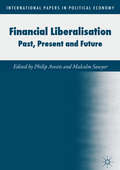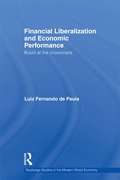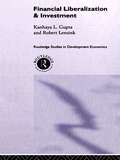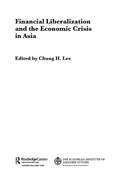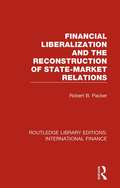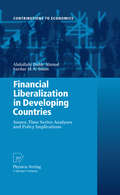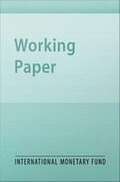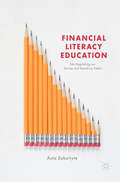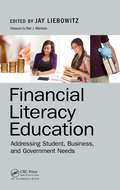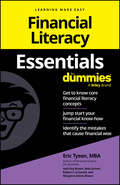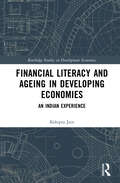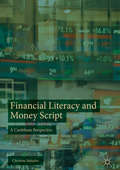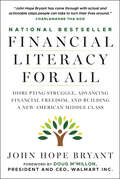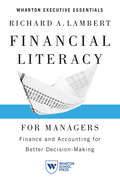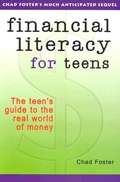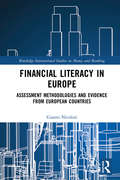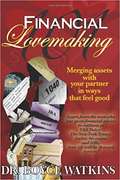- Table View
- List View
Financial Leverage, the Capital Asset Pricing Model and the Cost of Equity Capital
by David W. Mullins Jr.Demonstrates how the capital asset pricing model can be used to estimate the impact of financial leverage on the cost of equity capital. The levering and unlevering of betas are illustrated. Also presents a methodology for decomposing the cost of equity into its three components--the risk-free rate, a premium for business, and a premium for financial risk.
Financial Liberalisation
by Philip Arestis Malcolm SawyerThis book is the thirteenth volume in the International Papers in Political Economy (IPPE) series which explores the latest developments in political economy. A collection of eight papers, the book concentrates on the deregulation of domestic financial markets and discusses financial liberalisation in terms of its past performance, current progress and future developments. The chapters have been written by expert contributors in the field and focus on topics such as past records of financial liberalisation, future policies of regulation, and current account imbalances. Other papers examine capital account regulations in developing and emerging countries, and capital controls in the Eurozone after the 2007 financial crisis. This collection of papers invites readers to consider the impact of financial liberalisation both during and after the global economic crisis. Scholars and students with an interest in political economy, financialisation, and economic performance will find this collection stimulating and informative.
Financial Liberalization and Economic Performance: Brazil at the Crossroads (Routledge Studies In The Modern World Economy Ser. #85)
by Luiz Fernando de PaulaSince the beginning of the 1990s, Brazil has followed a pattern of economic development inspired by Washington Consensus. This framework includes a set of liberalising and market friendly policies such as privatisation, trade liberalization, stimulus to foreign direct investment, tax reform, and social security reforms. This book assesses the determinants and impacts of financial liberalisation in Brazil considering its two dimensions: the opening up of the balance of payments capital account, and the penetration by foreign bank of the domestic banking sector. The author combines theoretical and empirical analyses. Some make use of mathematical models and/or statistical techniques; however, they are only used when they are strictly necessary to the analysis.
Financial Liberalization and Financial Fragility*
by Enrica Detragiache Ash Demirgüç-KuntA report from the International Monetary Fund.
Financial Liberalization and Investment (Routledge Studies In Development Economics Ser.)
by Kanhaya Gupta Robert LensinkFor two decades thinking on economic policy has been dominated by the idea of economic liberalization in general and financial deregulation in particular. This field has become both extensive and controversial, yet there is no single book which treats financial deregulation in a complete and coherent manner. This book rectifies the shortfall by foc
Financial Liberalization and the Economic Crisis in Asia (European Institute of Japanese Studies East Asian Economics and Business Series)
by Chung H. LeeWhat brought about a financial crisis in the "miracle" economies of Asia? What went wrong with financial reform in Asia? What can the developing countries of the world learn from the reform experiences in Asia?Financial Liberalization and the Economic Crisis in Asia analyses how financial liberalization was undertaken in eight Asian countries and how it might be linked to the subsequent crises. The country studies focus on China, India, Indonesia, Japan, Malaysia, the Philippines, South Korea and Thailand.
Financial Liberalization and the Reconstruction of State-Market Relations (Financial Sector of the American Economy)
by Robert B. PackerIn this study, the author hopes to add to the literature concerning the distributional consequences of financial integration by focusing on the rise of non-state actors within a transformed international system. In it, he argues that structural change brought on by transnational production and post-industrialization has created space for non-state actors to acquire autonomy from sovereign entities. While finance is by no means the only specialized sector to achieve autonomy, it has perhaps the most immediate impact on the ability of governments to pursue policy. First published in 1999. Routledge is an imprint of Taylor & Francis, an informa company.
Financial Liberalization and the Reconstruction of State-Market Relations (Routledge Library Editions: International Finance #4)
by Robert B. PackerThe central theme of this study, first published in 1998, is that parametric change has expanded the autonomy of non-state actors, and has reduced the capability of governments to extract involuntary resources from their constituents. This change has profound consequences for world politics. This title will be of interest to students of Finance and Economics.
Financial Liberalization in Developing Countries
by Abdullahi Dahir Ahmed Sardar M. IslamThe latest global financial and economic crisis of 2008 has shown the need to re-examine the desirability of financial liberalization. This book is undertaking such a study on the issue of financial and market liberalization by adopting sophisticated econometric methods. It examines the effects of financial liberalization on economic development and social welfare using a case study approach on a sample of three Sub-Saharan African and an Asian country in which financial liberalization reforms were implemented. Further, it highlights some key causes of the failure of reform, and the policies and institutions that are needed to create an environment for successful financial liberalization. From the detailed country assessments, various policies such as effective competition in the banking sector, sound legal system, fiscal discipline and financial institutional development are identified, adoption of which can improve the efficiency of resource allocation, boost savings and impact growth, and thus lead to welfare enhancement.
Financial Liberalization, Money Demand, and Monetary Policy in Asian Countries
by Robert Corker Wanda TsengThis study examines the financial reforms undertaken by nine Asian countries in the 1980s (Indonesia, Korea, Malaysia, Myanmar, Nepal, the Philippines, Singapore, Sri Lanka, and Thailand) and their implications for money demand and monetary policy.
Financial Liberalization, Structural Change, and Real Exchange Rate Appreciations
by Carlos Urrutia Felipe MezaA report from the International Monetary Fund.
Financial Literacy Education
by Asta ZokaityteThis book explores the issue of consumer financial education, responding to increased interest in, and calls to improve peoples' financial literacy skills and abilities to understand and manage their money. New conceptual frameworks introduced in the book offer academic audiences an innovative way of thinking about the project on financial literacy education. Using the concepts of 'edu-regulation' and 'financial knowledge democratisation' to analyse the financial education project in the UK, the book exposes serious, and often ignored, limitations to using information and education as tools for consumer protection. It challenges the mainstream representation of financial literacy education as a viable solution to consumer financial exclusion and poverty. Instead, it argues that the project on financial literacy education fails to acknowledge important dependences between consumer financial behaviour and the socio-economic, political, and cultural context within which consumers live. Finally, it reveals how these international and national calls for ever greater financial education oversimplify and underestimate the complexity of consumer financial decision-making in our modern times.
Financial Literacy Education: Addressing Student, Business, and Government Needs
by Jay LiebowitzToday's graduates should be grounded in the basics of personal finance and possess the skills and knowledge necessary to make informed decisions and take responsibility for their own financial well-being. Faced with an array of complex financial services and sophisticated products, many graduates lack the knowledge and skills to make rational, informed decisions on the use of their money and planning for future events, such as retirement.This book shows what you can do to improve financial literacy awareness and education. It covers the use of interactive games and tutorials, peer-to-peer mentoring, and financial literacy contests in addition to more formal education. It gives you a sample of approaches and experiences in the financial literacy arena. Divided into three parts, the book covers financial literacy education for grades K–12, college, and post-college.
Financial Literacy Essentials For Dummies
by Eric TysonYour to-the-point guide on the essentials of managing your finances The first step in becoming a better personal financial manager is understanding the pillars of personal finance. Financial Literacy Essentials For Dummies is your cheat sheet on understanding how to better manage your finances. Distilled down to the essentials, this book makes it easy for anyone to learn the basics of managing money. You won't be able to escape life's many expenses, but with this book, you can get a grip on smart spending, saving, investing, and beyond. Start by creating a realistic budget for your situation and make a plan for achieving your goals. Money doesn't have to be scary with this Essentials guide. Get quick-and-easy explanations budgeting, savings accounts, and debt Understand how much you can really afford to spend, and learn to spend smarter Make a plan for getting out of debt—or avoid getting into debt in the first place Ensure that you have enough of a buffer to deal with unexpected expenses Need easy-to-understand information to help get your finances on track? Financial Literacy Essentials For Dummies is the guide for you.
Financial Literacy Strategies
by John Case Karen Berman Joe KnightIf your goal is to have a financially intelligent workplace or department, your first step should be developing a strategy for getting there. This chapter outlines three approaches that have proven effective in making financial literacy part of a company's culture.
Financial Literacy Strategies: For Entrepreneurs
by Karen Berman Joe KnightIn order to have a financially intelligent company, you must first figure out a strategy for getting there. This chapter outlines three approaches that have proven effective in making financial literacy part of a company's culture. This chapter is excerpted from "Financial Intelligence for Entrepreneurs: What You Really Need to Know About the Numbers."
Financial Literacy and Ageing in Developing Economies: An Indian Experience (Routledge Studies in Development Economics)
by Kshipra JainThis book weaves together current understanding around financial literacy and ageing, arguing for the relevance of financial literacy for old age security. Building upon on the experiences of ten developing Asian economies with a focus on India, the book enters new territory by developing frameworks that identify predictors of financial literacy and a mechanism for its internalization, as well as recognising the need for specialized training programs for the older population in order to establish a link between financial literacy and old age security. It thus makes a case about the centrality of financial literacy in creating an environment conducive to a dignified ageing experience in this world of shouldering one’s own responsibility. Going forward, the book comprehends financial literacy for India as a skill which enables an individual to decide the suitable avenues to invest savings, utilize monetary resources and shape financial decisions aligned with their financial goals, in accordance with the dynamic financial & economic environment. This original volume is a first-time attempt to provide an in-depth account of financial literacy and its association with savings behavior, old age planning, wealth accumulation, healthcare and wellbeing in older age. It also provides a detailed account of various measurement tools used and policy initiatives undertaken across the globe for financial literacy. It is an indispensable reference guide for scholars and researchers, cutting across multiple disciplines particularly financial and development economics, gerontology, demography, social work, psychology and public policy.
Financial Literacy and Corporate Performance
by John Case Karen Berman Joe KnightThis chapter discusses how financial intelligence empowers managers to make better decisions and contribute to a business's health, and advises organizations to take the next step and support the financial training of the entire staff.
Financial Literacy and Money Script: A Caribbean Perspective
by Christine SahadeoSince the financial crisis, everyone is more aware of the need to be financially literate. This book covers a wide range of topics and assures the reader that understanding of one’s money script and more particularly making changes (if necessary) would result in more effective and responsible managing and handling of one’s financial affairs. It is a misnomer that graduates of tertiary education are financially literate or are qualified to make financial decisions. In fact, they are particularly vulnerable in making poor financial decisions as many students do not undertake courses in financial education and they therefore have limited financial knowledge. Training in financial literacy through university-based financial education programs is one method of addressing personal finances and financial stress among students. This book presents the key components of financial education designed to address the growing concerns associated with high levels of debt, abuse of credit cards, home ownership, savings and investments, risk management, and retirement. The chapters on entrepreneurship and business planning provide a roadmap for successful new ventures. The book is an excellent resource for students, those interested in developing or enhancing their understanding of money matters and financial wellbeing, and trainers involved in financial education, counseling, and planning.
Financial Literacy for All: Disrupting Struggle, Advancing Financial Freedom, and Building a New American Middle Class
by John Hope BryantA new approach to understanding money and achieving financial fulfillment Former Vice-Chairman of the U.S. President's Advisory Council on Financial Literacy, John Hope Bryant, delivers an accessible and powerful resource for everyday Americans seeking to build a strong financial foundation. This book is an easy-to-read first step toward a fulfilling financial future, helping you understand your relationship to work and money, and a key component to untangling the surprisingly simple puzzle of personal finance. With an insightful forward by Doug McMillon, President and CEO of Walmart Inc., you'll learn how to create wealth for yourself and your family, regardless of your educational or employment background, and how to establish a financial mindset that contributes to a sound future. You'll also discover: The answers to tough money questions, including the actual utility of new financial inventions like cryptocurrency How to think about exchanging your time and effort for money and the conditions under which you should agree to work Plain-English discussions of the principles of responsible long-term investing and how it differs from speculation Acting as a critical pillar for those seeking to build a rock-solid financial foundation, Financial Literacy for All is a must-have book for working professionals, blue-collar workers, members of young families, and established businesspeople looking for a better, more secure future for themselves and the ones they care about.
Financial Literacy for Managers: Finance and Accounting for Better Decision-Making (Wharton Executive Essentials)
by Richard A. LambertThe language of businessIn order to understand how your business is performing right now and to evaluate, assess, and devise new strategies to boost future performance, you need information. Financial statements are a critical source of the information you need.In direct and simple terms, Richard A. Lambert, Miller-Sherrerd Professor of Accounting at the Wharton School of the University of Pennsylvania, demystifies financial statements and concepts and shows you how you can apply this information to make better business decisions for long-term profit. You will learn to use and interpret financial data; find out what we can learn from Pepsi, Krispy Kreme, General Motors, and other companies; learn how to evaluate investment strategies; and apply your financial know-how to develop a coherent business strategy.
Financial Literacy for Teens
by Chad FosterThe teen's guide to good financial habits at an early age - habits that will enable them to successfully make, manage, multiply, and protect their hard-earned money.
Financial Literacy in Europe: Assessment Methodologies and Evidence from European Countries (Routledge International Studies in Money and Banking)
by Gianni NicoliniAre people ready to take pivotal financial decisions like choosing a mortgage, saving for retirement, or investing their savings? How does the degree of knowledge about financial products and services affect the quality of their choices? Can financial fraud be prevented by increasing consumer financial knowledge? Financial Literacy in Europe addresses these important questions and more. In the first part, the author investigates the concept of financial literacy by analyzing its components and comparing different definitions from previous studies. This then forms a comprehensive measure of financial literacy to be applied in empirical studies that analyze the role of financial literacy in explaining consumers’ financial behaviors. In the second part of the study, the author uses brand new data collected by the Consumer Finance Research Center (CFRC) from several European countries (the UK, Germany, France, Italy, Sweden, and Spain) to assess financial literacy in Europe and highlight similarities and differences across countries. Filling an important gap in previous research, the author develops a rigorous approach in the measurement of financial literacy in order to examine European financial literacy issues in great detail. This book, therefore, is a useful resource for assessing the effectiveness of single financial education programs or planning national strategies on financial education. It can also support policy makers in developing financial regulation and consumer protection strategies, considering the consumer perspective and their ability to deal with financial markets and institutions.
Financial Literacy, Transparency, and Your Business's Performance: Why Entrepreneurs Should Bring Financial Intelligence to Work
by Karen Berman Joe KnightFinancial intelligence empowers entrepreneurs to make better decisions that contribute to a business's health, and support the financial training of the entire staff. Plenty of entrepreneurs have focused on developing financial intelligence and have found that the investment of time is repaid in productivity and employee satisfaction. This chapter is excerpted from "Financial Intelligence for Entrepreneurs: What You Really Need to Know About the Numbers."
Financial Lovemaking 101: Merging Assets With Your Partner in Ways That Feel Good
by Boyce WatkinsThis book teaches couples to use money as a tool to enhance their relationships, rather than as a weapon to destroy them. Dr. Boyce Watkins, a prominent Finance Professor who gives advice to millions through CNN, USA Today, Forbes Magazine and many other outlets, teaches couples to manage their money and strengthen their love, all at the same time. He teaches concepts such as getting financially naked with your partner, the art of financial foreplay, and reaching financial climaxes together. Reading this book will help you create the financial future you want, and maximize the love in your life.

